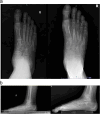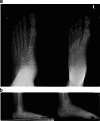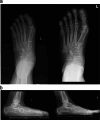Clinical and radiological outcomes of Evan's osteotomy in young patients with flexible flatfoot deformity: a retrospective investigation
- PMID: 40775712
- PMCID: PMC12329906
- DOI: 10.1186/s12891-025-08978-1
Clinical and radiological outcomes of Evan's osteotomy in young patients with flexible flatfoot deformity: a retrospective investigation
Abstract
Objective: Flexible flat foot deformity refers to a deformity where there is a decrease in or absence of the medial longitudinal arch of the foot upon weight-bearing along with hindfoot valgus, midfoot abduction and forefoot varus. Evan’s calcaneal osteotomy is a standard procedure used globally to correct deformities when clinically indicated, but its qualitative clinical and radiological outcomes have rarely been discussed. This study aimed to examine patients’ quality of life and radiological improvement after Evan’s osteotomy.
Methods: Data were obtained retrospectively from the orthopedic database of Jordan University Hospital, including a total of 27 patients between the ages of 8 and 23 years who underwent Evan’s calcaneal osteotomy for flexible flatfoot deformity within the specified period (2017–2021). Eight radiological parameters were used to assess and compare X-rays, while the foot health status questionnaire (FHSQ) was used to compare their preoperative and 6-month postoperative characteristics.
Results: Postoperative clinical outcomes revealed that footwear scores (p = 0.002), general foot health (MD = 2.46 ± 0.72, p = 0.001), and FSHQ scores were significantly greater (MD = 2.54 ± 0.59, p = 0.001) than preoperative scores were. In addition, the postoperative talocalcaneal angle values, calcaneo-cuboid angle (CCA), talo-1st metatarsal angle, talar declination angle (TDA) and Meary’s angle were significantly lower than the preoperative values. However, talar head coverage (MD=-10.23% ± 6.80%, p < 0.001) and the calcaneal inclination angle (CIA) (MD=-9.89 ± 6.47, p < 0.001) were significantly greater postoperatively than preoperatively.
Conclusion: Significant clinical and radiological improvement were achieved with Evan’s osteotomy. This is very important for providing physicians with concrete qualitative data when surgery is indicated for symptomatic patients and highlights the importance of performing a meticulous surgical technique addressing all aspects of the pathology for a better outcome.
Supplementary Information: The online version contains supplementary material available at 10.1186/s12891-025-08978-1.
Keywords: Adolescent; Deformity; Evans; Flatfoot; Flexible.
Conflict of interest statement
Declarations. Ethics approval and consent to participate: This study ensured patient confidentiality, received approval from Jordan University Hospital (JUH) and the Institutional Review Board ethics committee (IRB) at the University of Jordan, and was performed in accordance with the ethical standards and principles of the World Medical Association Declaration of Helsinki. Written informed consent to participate was obtained from all participants/their parent/guardian. Consent for publication: Not applicable as no personal or clinical details of participants that would compromise anonymity were published. Competing interests: The authors declare no competing interests.
Figures




Similar articles
-
Comparison of Allograft and Bovine Xenograft in Calcaneal Lengthening Osteotomy for Flatfoot Deformity in Cerebral Palsy.J Pediatr Orthop. 2017 Apr/May;37(3):e202-e208. doi: 10.1097/BPO.0000000000000822. J Pediatr Orthop. 2017. PMID: 27379788
-
Is There a Benefit to Rigid Fixation in Calcaneal Lengthening Osteotomy in Painful Pediatric Idiopathic Flatfoot Deformity? Comparing Results of Kirschner Wire Versus Plate Fixation.J Pediatr Orthop. 2023 Nov-Dec 01;43(10):e823-e827. doi: 10.1097/BPO.0000000000002514. Epub 2023 Sep 9. J Pediatr Orthop. 2023. PMID: 37694614
-
Minimally invasive surgery in medial displacement calcaneal osteotomy for acquired flatfoot deformity: a systematic review of the literature.Arch Orthop Trauma Surg. 2024 Mar;144(3):1139-1147. doi: 10.1007/s00402-023-05188-z. Epub 2024 Jan 11. Arch Orthop Trauma Surg. 2024. PMID: 38212588
-
Lateral Column Lengthening For Flexible Adult Acquired Flatfoot: Systematic Review and Meta-Analysis.J Foot Ankle Surg. 2021 Nov-Dec;60(6):1254-1269. doi: 10.1053/j.jfas.2021.02.015. Epub 2021 Jun 17. J Foot Ankle Surg. 2021. PMID: 34253434
-
Reported selection criteria for adult acquired flatfoot deformity and posterior tibial tendon dysfunction: Are they one and the same? A systematic review.PLoS One. 2017 Dec 1;12(12):e0187201. doi: 10.1371/journal.pone.0187201. eCollection 2017. PLoS One. 2017. PMID: 29194449 Free PMC article.
References
-
- Turner C, Gardiner MD, Midgley A, Stefanis A. A guide to the management of paediatric Pes planus. Aust J Gen Pract. 2020;49(5):245–9. - PubMed
-
- Park MS, Kwon SS, Lee SY, Lee KM, Kim TG, Chung CY. Spontaneous improvement of radiographic indices for idiopathic planovalgus with age. J Bone Joint Surg Am. 2013;95(24):e1931–8. - PubMed
-
- Carr JB, Yang S, Lather LA. Pediatric pes planus: a state-of-the-art review. Pediatrics. 2016;137(3):e20151230. - PubMed
-
- Dare D, Dodwell E. Pediatric flatfoot: cause, epidemiology, assessment, and treatment. Curr Opin Pediatr [Internet]. 2014 Feb [cited 2024 Jul 7];26(1). Available from: https://pubmed.ncbi.nlm.nih.gov/24346183/ - PubMed
-
- Ettinger S, Mattinger T, Stukenborg-Colsman C, Yao D, Claassen L, Daniilidis K, Plaass C. Outcomes of Evans Versus Hintermann Calcaneal Lengthening Osteotomy for Flexible Flatfoot. Foot Ankle Int [Internet]. 2019 Jun [cited 2024 Jul 7];40(6). Available from: https://pubmed.ncbi.nlm.nih.gov/30866668/ - PubMed
LinkOut - more resources
Full Text Sources

